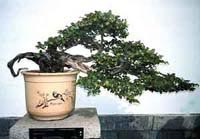Resource Library
Plant of the Week: Bonsai
The University of Arkansas System Division of Agriculture does not promote, support or recommend plants featured in "Plant of the Week." Please consult your local Extension office for plants suitable for your region.
Plant of the Week
Bonsai
Latin: Bonsai Lorapetalum

The ancient art of bonsai is a curious hobby that challenges the skills of patience, cultivation and artistry in ways unique among gardeners. The typical gardener, nay the typical American, has been brought up on the "bigger is better philosophy," which leads to super-sized meals in fast food joints, SUV’s the size of homes in third world nations and flowers so large they sometimes look deformed.
The slow, gentle art of bonsai turns this concept on its head.
Bonsai, correctly pronounced "bone-zi" not "bon-zi," which is a Japanese cheer, is often considered a Japanese art form, but its roots actually lie in China. The art form is known as penjing in China, and archeological records follow it back to at least 1000 BC. But it was during the T’ang Dynasty (618-907 AD), a period known for its poetry and attention to the arts, that the art form became fully established.
The cultivation of dwarfed trees in pots moved to Japan, probably in the 13th century, where it flourished in a culture very much in tune with nature and the introspective values of Buddhism. At first, trees that were naturally dwarfed were collected from the wild. As this natural supply of specimens was exhausted, gardeners began growing their own plants and creating well defined rules that spoke to both their cultural and religious aesthetic.
Bonsai is an attempt to grow a tree in a container that has all of the aesthetic appeal of a
comparable 300-year old tree growing in the wild, but at 1/100th scale. Five basic styles of training have evolved that emulate the look of trees found in nature in different situations. The formal upright style is often used with pines and other symmetrical trees that have a uniform and predictable habit.
The informal upright and slanting style are variations on the upright theme but create more energy and movement. They simulate the wind-swept look of trees that one might encounter along a coastline. The cascading and semi-cascading styles are more distressed styles that emulate trees one might find growing at the top of a cliff where they’ve been forced into a defensive posture by poor soils and continual buffeting by the elements.
As all procrastinating gardeners realize, growing any plant in a container long enough tends to dwarf it. Bonsai growers capitalize on this natural tendency and every couple of years remove their plants from their containers and severely prune the roots. This root pruning, coupled with the environmental constraints of the container, result in reduced leaf size and short stem growth.
Many bonsai are over 350 years old, so trees take on a really tortured look as they attain old-growth status in a pot.
Not all trees make good bonsai subjects. The ideal subject is a species with small leaves, close internodes, attractive bark characteristics and a propensity to branch freely. Pines, junipers, elms, zelkova, Japanese maple and boxwood are common starting points for beginners. Unlike most gardeners who select their plants on the principle of bigness and fullness, bonsai growers often look for the runts and malformed amongst the nursery offerings.
Most bonsai trees are temperate species that are kept outside during the entire year and brought indoors only during special occasions, and then only for a day or two. Because they are container grown, the roots must be protected from freezing during the winter months. Houseplants and tropical species can also be treated as bonsai subjects and kept indoors year round.
Growing bonsai requires a ground-up approach to gardening. First, the container medium must be well drained and nutrient poor. Typically a mixture of 2 parts coarse sand, one part of peat and one part of loamy soil is a good starting point. Fertilization is usually very light and is usually applied in the spring just before new growth begins. During the summer bonsai may require daily watering, depending on the exposure and container size employed. Pruning and training is an ongoing requirement that sculpts the tree into the image the grower desires.
The best bonsai collection in the United States is at the National Arboretum in Washington, D.C. The National Bonsai Collection had its beginning in 1975 when the Nippon Bonsai Association in Tokyo gave a gift of 53 plants to the people of the United States in celebration of the bicentennial. The plants ranged from 30 to 350 years old. In 1986, a significant collection of 200-year old trees was presented by donors from Hong Kong. Today the collection houses over 250 trees.
By: Gerald Klingaman, retired
Extension Horticulturist - Ornamentals
Extension News - December 14, 2001
The University of Arkansas System Division of Agriculture does not maintain lists of retail outlets where these plants can be purchased. Please check your local nursery or other retail outlets to ask about the availability of these plants for your growing area.